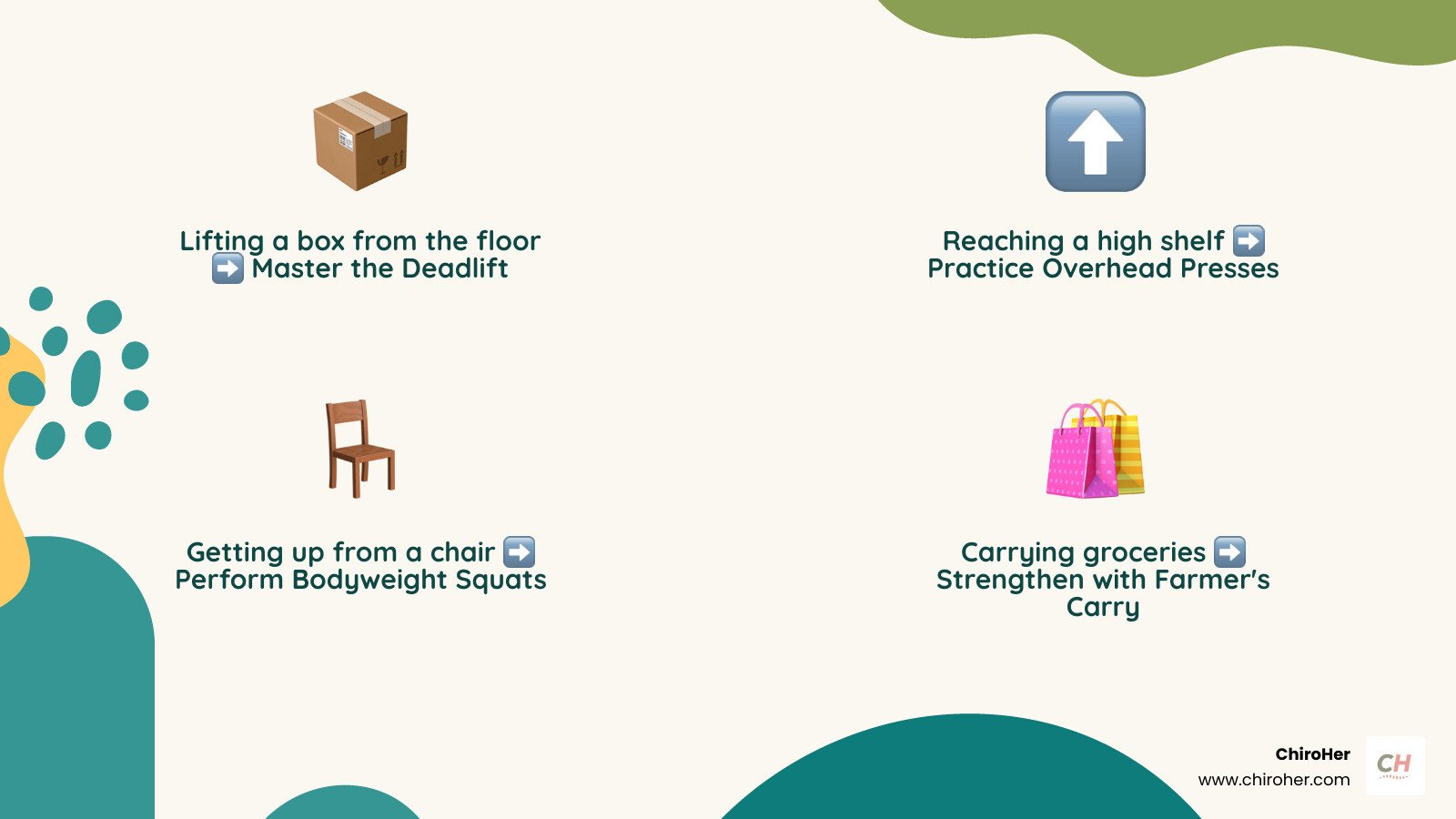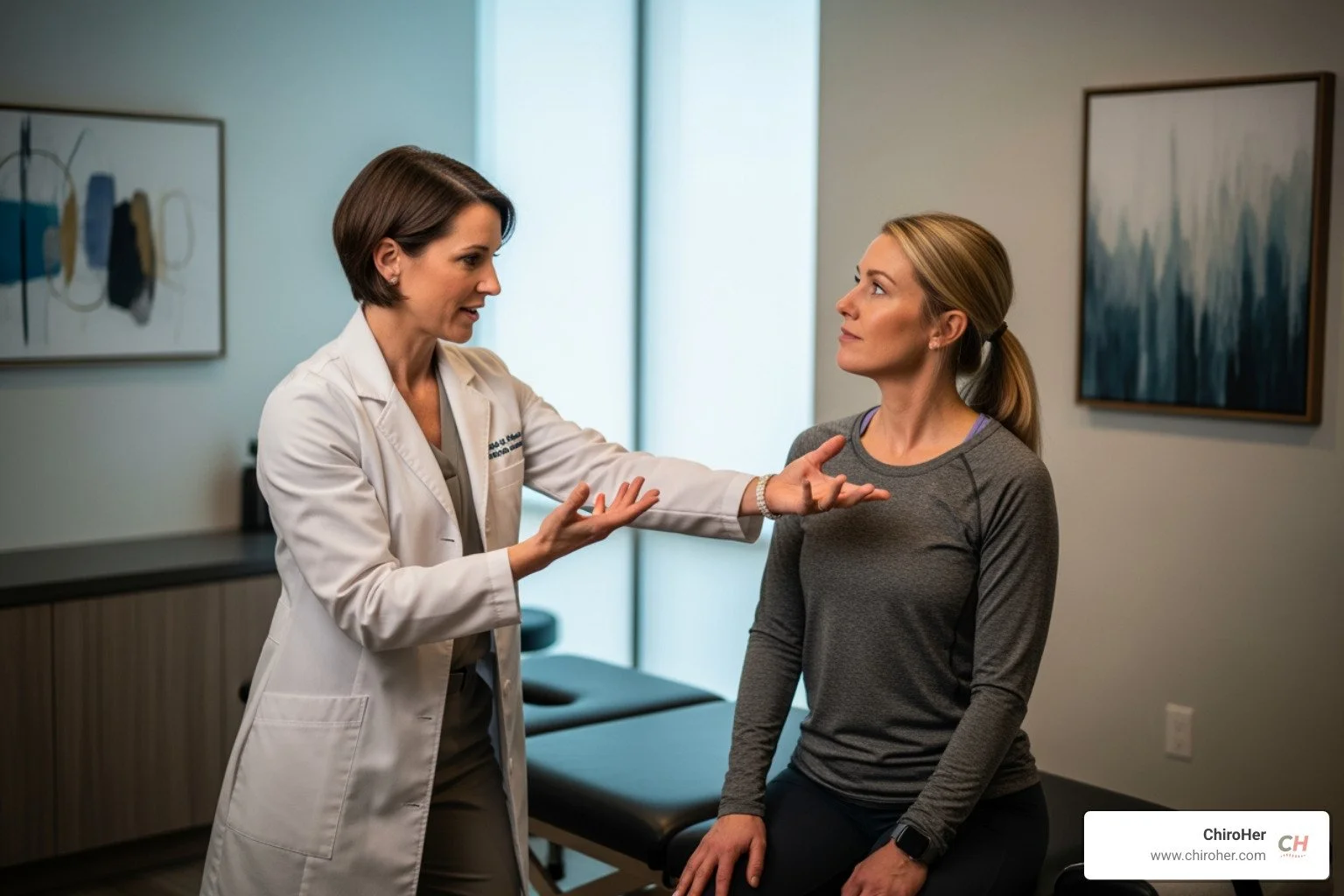Move Better, Live Better: A Comprehensive Guide to Functional Exercises
Why Functional Movement Matters for Your Body and Your Life
Functional movement exercises are workouts that train your body for real-life activities. Instead of isolating individual muscles on a machine, they focus on the compound movements you use every day, like bending, lifting, and carrying. The goal is to improve how you move through life, making daily tasks easier and reducing the risk of injury.
These exercises mimic daily life by using multiple joints and muscle groups at once. They build practical strength, balance, and coordination, often with minimal equipment. All human movement is built on seven core patterns:
Push (pushing a door open)
Pull (carrying groceries)
Squat (sitting and standing)
Lunge (climbing stairs)
Hinge (lifting a box from the floor)
Twist (reaching across your body)
Walk/Run (basic locomotion)
According to the Centers for Disease Control and Prevention, many older adults struggle with basic actions like picking something up from the floor. Maintaining functional strength is key to staying capable and independent throughout life. A deadlift prepares you to lift a heavy box safely, and a squat helps you get up from the floor after playing with your kids. These exercises directly translate to a more capable, pain-free life.
Hi! I'm Dr. Michelle Andrews, founder of ChiroHer in Oklahoma City. Over the years working with expecting mothers, athletes, and busy professionals, I've seen how incorporating functional movement exercises into care plans helps patients move better, feel stronger, and live with less pain. My focus on mobility improvement and sports recovery has taught me that the best exercise program is one that makes your real life easier.
What is Functional Training and Why Does It Matter?
Think about your daily routine: you bend to tie your shoes, reach for a mug, and twist to grab your bag. Each movement requires your body to work as a coordinated unit. That's what functional movement exercises train you to do.
Functional training focuses on movements that help you function better in everyday life. Unlike traditional workouts that isolate one muscle at a time, these exercises use compound movements that recruit several muscle groups at once. The focus isn't just aesthetics; it's about moving well, carrying groceries without back strain, and getting off the floor with ease. It's about building a body that supports the life you want to live.
Functional vs. Traditional Strength Training
Understanding the difference between functional and traditional training clarifies why these exercises are so effective for everyday life. Traditional training often uses machines to build muscle, but it doesn't always teach your body how to stabilize itself during complex movements. Functional training emphasizes moving your body through space, engaging your core, and training your body to work as an integrated system.
Feature Functional Training Traditional Strength Training Movement Focus Multi-joint, compound movements that mimic everyday activities. Exercises often involve the entire body working together. Often isolates single muscle groups or uses single-joint movements. Typically performed on machines that stabilize the body, allowing focus on one muscle. Goal Improve overall functional capacity, movement efficiency, reduce injury risk, and make daily tasks easier. Focuses on strength, balance, coordination, mobility, and stability. Build muscle mass (hypertrophy), increase maximal strength, or improve aesthetics. Often uses external resistance to target specific muscles. Equipment Can be done with minimal equipment (bodyweight, resistance bands, kettlebells, dumbbells) or no equipment at all. Emphasizes free weights and exercises that challenge stability. Often relies on gym machines, barbells, and dumbbells in a structured, often seated, environment. Real-world Transfer High. Directly translates to improved performance in daily life activities like lifting, bending, reaching, and walking. Variable. While it builds strength, the direct transfer to complex, multi-joint daily movements may be limited without additional functional programming. Core Engagement Significantly emphasizes core strength and stability as a foundation for all movements. The core is engaged to stabilize the spine and transfer force. Core engagement may be secondary or addressed through separate, isolated core exercises. Injury Prevention A primary benefit, as it strengthens muscles and improves movement patterns used in daily life, reducing strain and imbalances. Can help prevent injuries by strengthening muscles, but may not address movement patterns or stability as comprehensively.
The 7 Primal Movement Patterns
Your body is designed to move in seven fundamental ways. Mastering these patterns is the foundation of safe, effective movement.
Push: Pushing objects away from you. Think of a push-up or putting something on a high shelf.
Pull: Pulling objects toward you. This counteracts slouching and is used when opening a door or carrying bags. A dumbbell row is a great example.
Squat: A key movement for coordinating your limbs and core. You squat every time you sit in a chair. Start with a bodyweight squat.
Lunge: A single-leg movement vital for balance and stability, used when walking or climbing stairs. Try walking lunges.
Hinge: Bending at the hips with a neutral spine to protect your back. You should hinge to pick things up. Glute bridges are a great starting point.
Twist: Rotating your torso, which is important for reaching across your body or turning in a car.
Gait: Walking and running. This pattern combines all the others. A farmer's carry is an excellent exercise to improve gait and build strength.
Key Benefits for Your Everyday Life
The benefits of functional movement exercises go far beyond the gym.
Injury Prevention: By strengthening the muscles around your joints and improving movement mechanics, you reduce your risk of strains and sprains in daily life. For those recovering from an injury, we often recommend therapeutic exercises that restore proper movement patterns.
Improved Posture and Balance: Functional training builds core strength and corrects muscle imbalances, helping you stand and sit taller. Scientific research shows that a strong core improves posture, balance, and stability, which is valuable at any age. We often include correct posture exercises in our programs.
Easier Daily Tasks: This is where functional training shines. Lifting children, carrying groceries, and getting up from the floor all become easier. If you don't use these movement capabilities, you will lose them over time.
Weight Management: Because these exercises engage multiple large muscle groups at once, they burn more calories than isolated movements, which can contribute to weight management and positive changes in body composition.
A Practical Guide to Functional Movement Exercises
Now that you understand the why, let's cover the how. You can start right where you are, regardless of your current fitness level.
Starting Safely: Listening to Your Body and Prioritizing Form
Before starting any new program, it's wise to check with a healthcare professional, especially if you have pre-existing conditions. The most important rule is that form beats everything else. Master the movement with control before adding weight or speed. Listen to your body; stop if you feel sharp pain. Start with simple bodyweight exercises and progress gradually. Small, consistent wins lead to big changes.
Beginner, Intermediate, and Advanced Functional Movement Exercises
These exercises can be scaled for any fitness level.
Beginner: Focus on mastering basic patterns with good form.
Bodyweight Squat: Lower your hips as if sitting in a chair, keeping your chest up. (3 sets of 10-12 reps)
Plank: Hold a straight line from head to heels, engaging your core. (3 sets, 20-30 second hold)
Glute Bridge: Lie on your back with knees bent and lift your hips. (3 sets of 12-15 reps)
Intermediate: Add light resistance or stability challenges.
Goblet Squat: Hold a dumbbell or kettlebell at your chest while squatting. (3 sets of 10-12 reps)
Dumbbell Row: Hinge at your hips with a flat back and pull a dumbbell toward your hip. (3 sets of 10-12 reps per arm)
Walking Lunges: Step forward into a lunge, focusing on balance and control. (3 sets of 10-12 reps per leg)
Advanced: Incorporate more complex patterns and greater demands on balance.
Overhead Squat: Squat while holding a light weight or bar overhead with straight arms. (3 sets of 8-10 reps)
Push-up to Rotation: After a push-up, rotate your torso and reach one arm to the ceiling. (3 sets of 8-10 reps per side)
Single-leg Romanian Deadlift: Hinge at the hip on one leg while extending the other leg back. Check out how to do a Romanian Deadlift here.
Functional Fitness at Home: No Gym Required
You don't need a gym to build functional strength. Your living room is a great place to start.
Use your bodyweight: Squats, lunges, push-ups, and planks are powerful tools for building a strong foundation.
Get creative with resistance: A backpack with books, water bottles, or canned goods can serve as weights.
Try a simple circuit: Perform 10-15 reps of bodyweight squats, followed by push-ups, a 30-60 second plank, walking lunges, and glute bridges. Rest for 1-2 minutes and repeat the circuit 2-3 times.
The Crucial Role of Your Core
A strong core is the foundation of all functional movement. It's not about a six-pack; it's the deep network of muscles that stabilizes your spine and transfers power between your upper and lower body. A stable core protects your back during lifting, twisting, and carrying.
Focus on exercises that train these deep stabilizing muscles.
Dead Bug: Lie on your back and slowly lower an opposite arm and leg while keeping your low back on the floor.
Bird-Dog: On all fours, extend an opposite arm and leg while keeping your torso stable.
Pallof Press: Use a resistance band to challenge your anti-rotation strength by pressing the band away from your chest without letting your torso twist.
These exercises build the added benefits of core strength and stability that make daily movements feel effortless.
Integrating Functional Training Into Your Wellness Plan
Making functional training a part of your life doesn't require hours in the gym. Consistency is more important than intensity.
Frequency, Intensity, and Recovery
Frequency: Aim for two to three full-body sessions per week, with at least one rest day in between for recovery.
Intensity: Start with your bodyweight to master the form. Once a movement feels natural, you can increase the challenge by adding reps, sets, or light weights.
Warm-ups & Cool-downs: Never skip these. A 5-10 minute dynamic warm-up (like arm circles and leg swings) prepares your body for movement. A 5-10 minute cool-down with static stretching (holding stretches for 20-30 seconds) aids recovery.
Considerations for Pre-existing Conditions and Pregnancy
Functional training is adaptable, but modifications may be needed. If you have chronic pain, a past injury, or are pregnant, it's important to adjust your routine. For example, certain core exercises and rotational movements may need to be modified or avoided. During pregnancy, your balance and center of gravity shift, requiring thoughtful adjustments to stay safe. Always consult with your healthcare provider before starting a new program.
Importance of Professional Guidance for Personalized Plans
While this guide provides a foundation, nothing replaces personalized guidance. A qualified professional can identify movement imbalances, correct your form to prevent injury, and create a program that fits your specific needs and goals.
At ChiroHer, serving Oklahoma City, Yukon, Edmond, Nichols Hills, Del City, Mustang, and Moore, we help people move better and feel stronger every day. Our approach combines chiropractic care with therapeutic exercises focused on functional patterns. Whether you're recovering from an injury or simply want to make daily life easier, we can help you build a program that fits your body.
If you're ready to move with more confidence and less limitation, we'd be honored to support you. Schedule a consultation with us and let's talk about what functional training can do for you.
This guide is for informational purposes and is not a substitute for already established medical advice from your healthcare provider.




